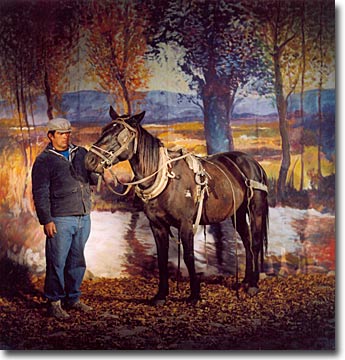Espacio Fundación Telefónica,
Jun 21, 2006 - Aug 20, 2006
Buenos Aires, Argentina
Downey Effect
by María Fernanda Cartagena
His video style is permeated by a profound and complex analysis concerning the construction of meanings through image. To this effect he resorted to a wide range of resources pertaining to different fields, one of the most impressive being the theatre, where he often acted and performed, transferring the private into the public sphere. His work shows great erudition, a vast gathering of information, countless collaborations and also much humor and irony. The Looking Glass (1982) is a powerful essay about the psychic and symbolic importance that Western culture places on the mirror. This research is masterfully orchestrated in the obsessive deconstruction he performs on Velazquez’ Las Meninas. In Chicago Boys (1983) and Motherland (1987) he delivers a sharp criticism against the military coup, U.S. interventionism and the implementation of neo-liberal policies in his native country. In Information Withheld (1983) and Shifters (1984), he examines the transmitting of contents through mass culture, high culture and other cultures, their inter-textual power and their transference on a global scale. His experimentation in the fields of editing and assembly was extreme, anticipating the digital age, post-modern intervention, fragmentation and zapping. J.S. Bach (1986), one of his last projects, dedicated to his mother who died just before he was to start filming, is the outcome of those brilliant moments of hyper-sensitivity that bear comparison to Barthes’ Camera Lucida.
As regards Downey’s importance for the artists in the show, the curator traces the "complicities unconsciously knotted together in the works." In the so-called juridical superstructure of the show, Mellado focuses on the discipline manifested in the representational strategies that the artists reveal through different formats and media. Adriana Bustos works on the politics of the pose in photographing a horse and its owner, a cartonero [collector of cardboard waste and other cast-offs]. Fredi Casco parodies the Sacred Family with the sharp-witted use of technology. Mario Navarro transposes and prints on heavy-duty fabric a photograph of an operation room which, in Chile, was part of a cyber intercommunications project, a sort of primitive "Socialist Internet." In this area we also find Ingrid Wildi and Claudia Cassarino who underscore the friction between private history and public discourse.
I am interested in speculating about how that "double gaze" to which I have been referring is articulated by these artists. How do they translate visually (consciously or unconsciously) the tension between the global and colonial nature of power as part of the spreading and perpetuating of the modern/colonial world-system? I suggest that this translation operates in a way similar to Downey's. Their works emerge in the threshold where concepts and knowledge of Western technology, culture and art - in which they are active participants-- interfere with the experience and history of various places, subjects and times that have been displaced, subordinated or marginalized by those very same concepts: in other words, where this joining together becomes problematic and therefore productive. In this powerful gaze, there will always be some identification with those who are subordinate. This analysis is not opposed to Mellado’s, but seeks to map, between Downey and the artists, the epistemological, political and desirous density unfolding in their gaze and visions out of this "geographic and epistemological border," to quote Mignolo.
|













